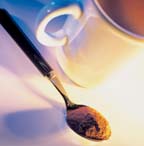
Reconstituting properties affect consumers' perception of quality, as consumers expect drink mix to dissolve immediately. They also impact food and beverage manufacturers, who require consistency and ease in handling.
Instantizing of powders is a complex matter because of the range in properties of the different types of materials that can be instantized, as well as the varying properties of the liquids into which the instantized powders are dispersed. For example, some powders are hydrophobic (e.g., whole milk powder), having a large amount of free-surface fat that forms a barrier and prevents liquid from penetrating it. Others are hydrophilic, or water-loving (e.g., protein powders), and rewet too quickly on the surface. When powders rewet too quickly, a gel layer forms, preventing liquid from penetrating the powder particles. The result in both scenarios is that the powders remain on the surface of the liquid. In other words, they do not readily dissolve.
To further complicate the process, it is often desirable to have powders that have the flexibility of being able to be dispersed in liquids with different properties. For example, with some beverage mixes, the same powder might be dissolved in cold or hot water, in cold nonfat milk (solids present), in cold whole milk (fat and solids present), in hot milk or even into high solids mixtures such as those used to make smoothies. This poses quite a challenge.
Whey protein powders are particularly challenging systems to instantize, as whey proteins vary in particle size, shape and surface properties. Thus, with whey protein powders, seldom will the same powder dissolve in all liquid systems. In fact, when deciding how to instantize whey protein powders, it is important to keep in mind that process is often application specific.
Finally, finished product quality depends on what type of instantizing process is actually used. In almost all cases, the instantizing process is optimized when a surface active ingredient is used, as surface active agents greatly enhance reconstituting properties.
Improving rewetting properties
There are two basic steps for improving powder rewetting properties-agglomeration and lecithination. Agglomeration imparts a coarse, porous structure to powders. Agglomeration relies on capillary forces within the cavities to allow the liquid to penetrate. As the granule sinks, the bridges formed during agglomeration dissolve and the product disintegrates.During the lecithination process, the powder is coated with a surface active agent that compensates for either the swelling of hydrophilic surfaces or the poor wettability of hydrophobic constituents. These steps may be used alone, but often times powders go through both steps in order to improve their ability to dissolve or disperse.
Surface active agent selection is critical to the desired performance for the finished product. Certain materials such as specialty lecithins and compounds based on specialty lecithins can be used with great efficiency. For example, you can improve the wetting time of a powder with 5% free surface fat by approximately 70% if you choose the correct type of lecithin. The wetting time is also maintained over a longer period of storage time. By choosing a high-performance lecithin product, you can increase the wettability at 6 months by 80%. To determine the best type of surface active agent for your product and process, it is important to work closely with your ingredient supplier to optimize your process.

